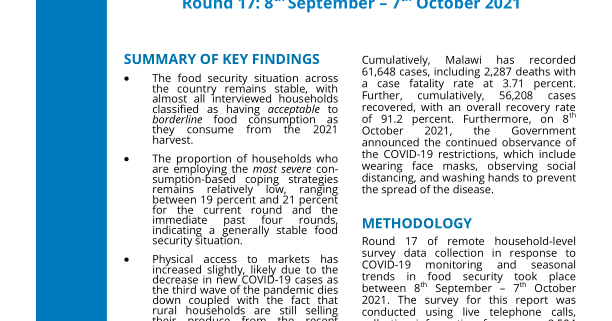Malawi Household Food Security Bulletin | Mobile Vulnerability Analysis and Mapping (mVAM) on the Effects of COVID-19 in Malawi Round 17: 8th September – 7 th October 2021 – Malawi
SUMMARY OF KEY FINDINGS
-
The food security situation across the country remains stable, with almost all interviewed households classified as having acceptable to borderline food consumption as they consume from the 2021 harvest.
-
The proportion of households who are employing the most severe consumption-based coping strategies remains relatively low, ranging between 19 percent and 21 percent for the current round and the immediate past four rounds, indicating a generally stable food security situation.
-
Physical access to markets has increased slightly, likely due to the decrease in new COVID-19 cases as the third wave of the pandemic dies down coupled with the fact that rural households are still selling their produce from the recent harvest.
BACKGROUND
During this reporting period, Malawi continued experiencing a decline in the number of COVID-19 cases, deaths, and admissions to Emergency Treatment Units (ETUs). As of the last day of this reporting period (7th October 2021), the Ministry of Health indicated that the country registered nine new COVID-19 cases in the past 24 hours, down from 952 cases during the peak of third wave on 22 July 2021.
Cumulatively, Malawi has recorded 61,648 cases, including 2,287 deaths with a case fatality rate at 3.71 percent.
Further, cumulatively, 56,208 cases recovered, with an overall recovery rate of 91.2 percent. Furthermore, on 8th October 2021, the Government announced the continued observance of the COVID-19 restrictions, which include wearing face masks, observing social distancing, and washing hands to prevent the spread of the disease.
METHODOLOGY
Round 17 of remote household-level survey data collection in response to COVID-19 monitoring and seasonal trends in food security took place between 8th September – 7 th October 2021. The survey for this report was conducted using live telephone calls, collecting information from some 2,504 households in all districts and major cities across the country.
The sample size was calculated based on the Integrated Food Security Phase Classification Technical Manual (Version 3.0) guideline of having at least 150 samples per strata. Additional details on this methodology are available in…


